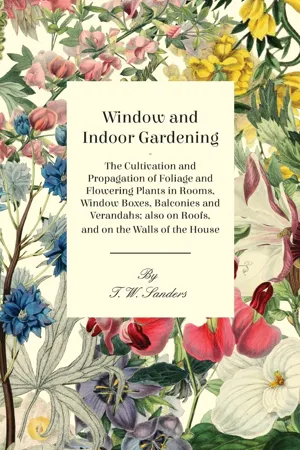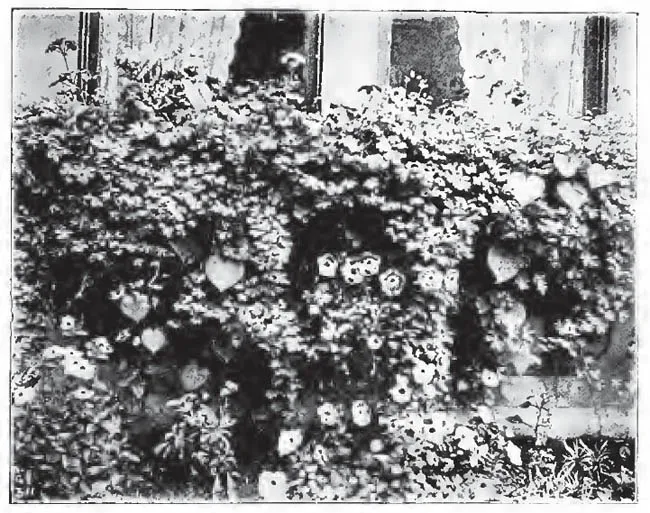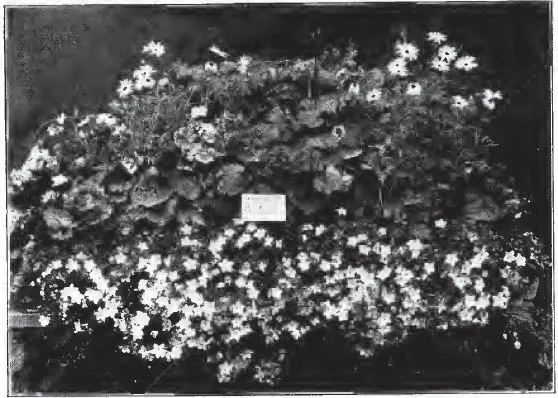![]()
Part I.—WINDOW AND BALCONY GARDENING.
![]()
CHAPTER I.
WINDOW BOXES.
FOR window-sill gardening boxes are essential if we would grow the plants really well, and ensure pretty effects. Pots have a somewhat ugly look about them, and, besides, the plants do not display their beauty to such good effect as when grouped together in a box. There are, of course, several types of boxes, and we will give a brief description of each.
Earthenware Boxes.—These are made in various patterns, in terra cotta and other earthenware, the most beautiful type being that known as “Doulton” ware. They are, of course, expensive, but where expense is no object, and an artistic box is desired, then by all means procure this type. Being absorbent, they suit the requirements of plant life admirably.
Zinc or Iron Boxes.—These are not so suitable for plant life as the preceding type. Their close texture prevents aeration of the soil, and they are easily affected by extremes of heat or cold. It is true, they are the most durable type of box. We are opposed to iron boxes, but are disposed to agree to zinc boxes being used as an inner sheeting to earthenware or wooden boxes. It is so easy to lift out a zinc shell, with soil and plants, and change the two, if desired. Ample provision must, however, be made for drainage.
A NEAT WINDOW-SILL GARDEN.
The box illustrated is supported by brackets fixed to the wall and planted with ivy and zonal pelargoninms and marguerites. One of many effective window-sill gardens attached to shops, etc., at Malvern, in Worcestershire.
Simple Wooden Boxes.—A simple and cheap box may be made of 9in. by lin. boards, painted green and faced with virgin cork. The joints should be given a thick coating of red lead paint before they are secured together with wire nails. After fixing, stipple more paint freely in the joints, then give the other parts at least two coats of good green paint, both inside and out. No soil should, however, be placed in the box until the paint has become thoroughly dry. Holes an inch wide should be bored three inches apart in the bottom to allow superfluous water to escape readily.
Ornate Boxes.—Make the box in the same way as advised in the last case, but, instead of facing it with virgin cork, cover it with pieces of split hazel or larch arranged in an artistic design, according to fancy. Secure them by means of small wire nails, and leave the bark on. Give the wood a coat of size, followed by three coats of varnish, and then a good class of box will be produced. Another style of box is one faced with planed wood in panels, and ornamented with fretwork. Anyone handy with tools may ornament the face in many ways. The main principle of a window-box, so far as its body is concerned, is to make it of good wood, well painted, and 9in. wide and 9in. deep, with plenty of drainage at the bottom. Any good carpenter or builder will soon make a serviceable box. The box should be stood on three strips of wood an inch or so square placed on the sill, one at each end and one in the centre. This is to allow air to get beneath the box, and so prevent its rotting.
Window Pot Guard.—This may be made in a simple fashion like a miniature open-paled fence, or with a fretwork facing. The object in each case is to prevent pots falling off the sill, and at the same time rendering them less unsightly from outside.
General Remarks.—On no account buy boxes faced with hideous blue, yellow, or red glazed tiles. These conflict with the colours of the flowers, and often spoil the beauty and charm of the floral arrangement. The more simple the design, and the more unobtrusive the colour, the better. After all, the object of a box is not so much for its artistic beauty as for its practical utility in holding soil for the plants. A box should be so planted with trailing plants that it is hidden from view—in summer, at any rate. It is a wise precaution to always have the ends of the boxes secured by stout wire to the walls, in order to prevent the former falling over, accidentally or otherwise.
![]()
CHAPTER II.
SOIL FOR WINDOW BOXES.
HAVING secured suitable boxes for the sills the next question is to provide adequate drainage and the requisite compost.
Drainage.—It is necessary to place an inch or so of some rough material in the bottom of the box, to enable superfluous water to easily pass through the holes. If the compost were placed directly on the bottom it would soon seal the holes, and the lower compost become waterlogged and sour.
The most suitable material for the purpose is cinders or coke, about the size of walnuts, or broken bricks or potsherds. An inch layer will suffice. Over this should be placed a thin layer of rough soil siftings, moss, tree leaves, or decayed manure. Ample drainage will thus be assured.
Compost.—For ordinary purposes two parts of fairly good garden mould and one part of equal proportions of fresh horse droppings rubbed through a half-inch sieve, and sand or grit will suffice. Those, however, who can afford to spend a few shillings in buying better materials—and which, by the way, will yield better results—should use a compost of two parts fibrous loam and one part of equal proportions of well-decayed manure, leaf-mould, and silver sand. To each bushel of this mixture add a pint of bonemeal. Old potting mould also makes a good compost, if a little well-rotted manure be added to it, for window-boxes. The ingredients in each case should be thoroughly mixed before they are placed in the box.
We may add here that the composts just advised will suffice for the whole year. The usual plan is to fill the boxes with fresh compost for the summer flowers, and, when these are cleared out in autumn, to be replaced by bulbs, etc., it has simply to be forked over, adding a handful each of bone-meal and soot before the forking takes place.
![]()
CHAPTER III.
WINDOW BOXES IN SUMMER.
IT is during the summer period that the majority of folk take the keenest interest in window-sill gardening, owing, no doubt, to the fact that the best results are obtained from a floral standpoint at that season of the year. Window-sill gardening may, however, be practised with success at other seasons, as we shall show later on. For the present our remarks must be confined to the summer period. In dealing with the subject of furnishing the boxes we shall bear in mind the interests of all classes of window gardeners.
A Cheap Display.—Those who want to furnish their boxes at the lowest possible cost should sow hardy annuals in the boxes in March or April. Seeds suitable for the purpose may be purchased in penny packets. Kinds suitable for the purpose are dwarf mixed nasturtiums, candytuft, Virginian stock, godetias, Meteor marigolds, sunflowers, tall nasturtiums, Canary Creeper, clarkias, eschscholtzias, mignonette, and sweet alyssum.
A sunflower seed or two, or a few seeds of sweet peas, may be sown at the ends of the box, to grow up the sides of the window; seeds of Canary Creeper or Tall Nasturtium close to the front of the box, to hang over the side: and seeds of the other annuals behind. A very pretty effect would be obtained by sowing tall nasturtiums in front and dwarf nasturtiums behind.
A SIMPLE WINDOW GARDEN.
This array of plant growth is made up chiefly of canary creeper, clin bing convolvnlns, and single petnnias; a zonal pelargoninm or two are in the background.
Another pretty arrangement would be to sow seeds of Canary Creeper in front, and eschscholtzias behind. Sow the seeds thinly, and afterwards thin the seedlings out to three or four inches apart. A box of Meteor marigolds, edged with Canary Creeper, also makes a charming picture, and so does an edging of Virginian stock with godetias behind. For a shilling it is possible to have an exceedingly cheap and showy floral display during the summer.
A Simple, Inexpensive Display.—At a slightly increased cost a very good display of colour may be obtained by planting half-hardy plants, such as French marigolds, salpiglossis, petunias, lobelias, and verbenas in the boxes in May. Seedlings can at that period be purchased at a cheap rate per dozen, and hence the cost is not a serious item. A box planted with one kind only yields the prettiest effect. Lobelias, however, are an exception; they should be used as an edging.
Superior Displays.—Where expense is not a matter of primary consideration, very showy and artistic floral displays may be made by utilising a more costly class of plants to those previously described. Thus, such plants as ivy-leaved and zonal pelargoniums, heliotropes, yellow and white marguerites, fuchsias, tuberous-rooted begonias, ageratums, lobelias, Tropæolum lobbianum, calceolarias, celosias, cupheas, lantanas, tobaccos, and petunias are available for yielding a wealth of blossom; while for coloured foliage the silvery-leaved centaureas, pelargoniums, and cinerarias; purple-leaved coleus, iresine, and perilla; and golden-leaved mesembryanthemums and pelargoniums are also at the disposal of the window gardener desirous of obtaining brilliant effects.
Tastes naturally vary as to arrangements, but the modern tendency is to plant boxes with one colour or with one kind of plant. Thus, one frequently observes a box planted solely with pink ivy-leaved pelargoniums, or yellow marguerites, or scarlet or crimson zonal pelargoniums, and the effect is certainly very pretty.
A PRIZE-WINNING WINDOW-BOX.
This box is well filled with, scarlet zonal pelargoniums, tuberous begonias, white marguerites, canary creeper, and Campanula isophylla alba.
Then, again, two-colour contrast schemes are favoured by some, such as an edging of blue lobelia with white marguerites behind; blue lobelia as an edging and scarlet pelargoniums behind; purple heliotropes behind and golden mesembryanthemums in front; or crimson or scarlet pelargoniums at the back and silvery-leaved ones in front.
Harmonic combinations are obtained by planting salpiglossis, or petunias, or fuchsias, or lantanas, in mixture by themselves in separate boxes. For ordinary purposes a mixture of petunias, pelargoniums, fuchsias, heliotrope, etc., will make an effective display.
Sometimes, also, a box is planted solely with coloured-leaved plants. Thus, Mesembryanthemum variegatum, golden-leaved, is used as an edging; then behind this a row of silvery-leaved Centaurea candidissima or Cineraria maritima, with purple-leaved Perilla nankinensis or Iresine Lindeni at the back.
Other combinations than those described will, of course, occur to the window gardener. At the end we give a list of plants, with their colours, heights, etc., for the reader to select the kinds and colours he prefers.
Shady Window Boxes.—Our remarks so far have been confined to sunny boxes, and now a word or so with regard to those which get little or no sunshine in summer. Apart from hardy ferns, dealt with elsewhere, there is only a limited number of plants that really do well in shade. For partial shade tuberous-rooted begonias may be strongly recommended as excellent plants for the purpose.
For partial or complete shade fuchsias, Sweet-scented Tobacco (Nicotiana affinis), yellow and brown calceolarias, musk, canary creeper, Creeping Jenny, tall and dwarf nasturtiums may be relied upon to do fairly well. Fuchsias and calceolarias will certainly succeed.
Fragrant Plants.—Those who desire to have one or more boxes filled with fragrant-leaved or flowered plants may grow one or more of the following plants: Mignonette, citron, peppermint, and balsam-sc...





